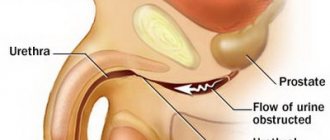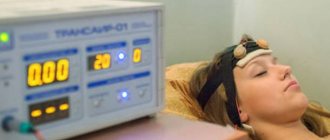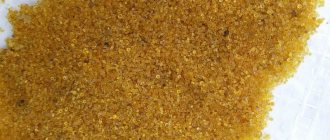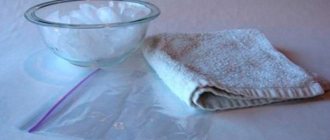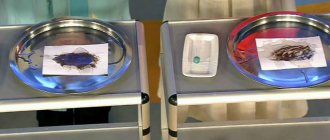Doctor Natroshvili A.G. consults and operates at gmshospital.ru. Make an appointment for a consultation by phone
- About the procedure
- Indications and contraindications for laparoscopy
- Preparing for surgery
- Carrying out laparoscopic cholecystectomy
- Hospital stay
- Rehabilitation period
- Diet after gallbladder removal
- Possible complications
- Cost of the procedure
Laparoscopic cholecystectomy is a surgical procedure in which the gallbladder is removed using special equipment under the control of a laparoscope. The main difference from the classical operation is that it is less traumatic. All manipulations are carried out through punctures in the abdominal wall; there is no need for large incisions. The recovery period takes up to 6 days. After one to two weeks, the patient returns to his normal lifestyle.
About the procedure
During the procedure, a laparoscope is used. This is a special device in the form of a probe with optics, with the help of which the image of the surgical field is transmitted to a video monitor. To perform a cholecystectomy, 3 to 4 small incisions are made on the abdominal wall. Through them, a laparoscope with a camera and manipulators are inserted to perform actions in the abdominal cavity.
To create space for manipulation, carbon dioxide is injected into the abdominal cavity. After removal of the gallbladder, it is removed through one of the ports, but a small amount (20-30 ml) may remain in the abdominal cavity, and the first few days may manifest itself as aching pain in the shoulder area (due to irritation of the phrenic nerve).
Complications after cholecystectomy performed using laparoscopic technology are minimal. Advantages of the operation:
- minimally invasive (minimal trauma)
- minimal pain syndrome;
- low likelihood of developing postoperative complications;
- short postoperative period and rehabilitation period;
- quick return to work.
Statistically, in approximately 5% of all cases, performing cholecystectomy laparoscopically becomes impractical for the following reasons:
- severe inflammatory process with the development of infiltrate around the gallbladder;
- anatomical abnormalities
- the presence of adhesions after previous operations.
In such situations, traditional or open cholecystectomy is indicated. It should be noted that with the accumulation of experience, the frequency of conversion to open surgery becomes significantly lower. There have been no such cases in our clinic over the past few years.
Why is the operation performed?
The gallbladder is an important part of the digestive system. Bile collects in it, and when food enters the small intestine, the bladder contracts and throws out 40-60 ml of its contents. Bile promotes the activation of digestive enzymes, emulsifies and hydrolyzes fats, and removes excess cholesterol and bilirubin from the body.
If pathology occurs, the gallbladder can cause severe disorders, from pain to damage to the liver, pancreas, and even the development of severe septic complications. A timely operation according to indications allows one to avoid the development of severe complications and at the same time does not significantly worsen the patient’s quality of life in the future.
Indications and contraindications for laparoscopy
Today, laparoscopic cholecystectomy is the “gold standard” and is indicated for:
- any form of symptomatic gallstone disease
- gallbladder polyps
- Cholelithiasis complicated by choledocholithiasis
Contraindications for laparoscopy are the same as for other types of operations:
- terminal state;
- decompensation of the functions of the cardiovascular system and lungs.
Where it is better to have laparoscopic cholecystectomy in Moscow, the patient chooses himself. It is better to give preference to a clinic with good recommendations and reviews, highly qualified surgeons, and modern equipment. The average cost of laparoscopic cholecystectomy as a service depends on these same factors.
Preparing for surgery
The methods of preparing for surgery are similar and do not depend on where laparoscopic cholecystectomy is performed in Moscow.
Before the procedure, the patient undergoes a full examination at the medical center. Laboratory and instrumental diagnostic measures are prescribed - blood and urine tests, ultrasound, and, if necessary, MRI. Their goal is to determine the patient’s health status and identify concomitant pathologies that require correction before surgery. If pathologies that impede the operation are identified, treatment will be prescribed to compensate for the disease.
In the absence of contraindications, cholecystectomy is prescribed. Preparation for the procedure:
- Follow a special diet the day before surgery. You can only eat light foods that do not overload the digestive tract.
- Dinner the day before is allowed no later than 19:00.
On the day of surgery, you should not eat or drink. If the patient regularly takes any medications, their use should be coordinated with the surgeon and anesthesiologist. In most cases, therapy is not interrupted.
Why is it better to have a cholecystectomy at the Swiss University Hospital?
- Surgical clinics have enormous experience in performing operations; we perform more than 120 surgical interventions every month, some operations are performed only here.
- Our employees are the authors of more than 100 unique techniques; about 40 patents for bloodless surgical interventions have been developed by us.
- We were one of the first to perform operations on the organs of the peritoneal cavity using SILS technology; we have more than 25 years of practice behind us.
- SwissClinic surgeons were among the first in the country to begin performing simultaneous operations - in the presence of several pathologies requiring surgical treatment - only one surgical intervention.
- During treatment, our specialists use the latest generation equipment, for example, ultrasonic scissors, LigaSure endoscopic staplers; during laparoscopy, anti-adhesion barriers and other well-proven methods are also actively used, which contributes to the fastest recovery.
How to remove the gallbladder
The laparoscopic cholecystectomy operation is performed under general anesthesia. Its duration is from 40 minutes to 3 hours, which depends on the diagnosis, form and severity of the disease, and the individual characteristics of the patient.
Operation stages:
- Puncture of the abdominal cavity with a special atraumatic needle through which carbon dioxide is injected. For this purpose, a special device is used - an insufflator. There is a constant supply of gas, and its constant pressure in the abdominal cavity is also maintained.
- Next, small punctures are made in the abdominal wall, through which laparoports are inserted. These are special devices for inserting surgical instruments into the abdominal cavity and preventing carbon dioxide from escaping.
- A laparoscope is inserted into the puncture in the navel area. This is a device in the form of a tube with optics at the end, which transmits images of internal organs to a monitor. The device magnifies the image several times, which makes the visualization of anatomical structures and tissues as clear as possible. Manipulations performed inside the abdominal cavity can be seen by all medical professionals present in the operating room.
- Through other laparoports, clamps are inserted to hold the gallbladder and other instruments are inserted to isolate structures and perform other stages of the operation.
- The most critical stage of the operation, the precision of which largely determines the success of the operation, is the isolation and intersection of the cystic duct and the artery supplying the gallbladder. We use the principle of critical safety view before crossing these structures, which minimizes the risk of damage to the main bile ducts and bleeding.
- Using the electrocoagulation method, the surgeon separates the gallbladder from the liver
- Next, through one of the punctures in the abdominal wall, the gallbladder is removed out into a special container.
- Surgical instruments and trocars are removed from the punctures (always under visual control to prevent bleeding from the trocar wounds. Sutures are placed on the incisions. We use intradermal sutures with absorbable material, which gives maximum cosmetic effect.
Sometimes, to prevent and early diagnose complications, drainage of the abdominal cavity is performed - a silicone tube is installed through one of the punctures. We are not supporters of this approach and resort to drainage only in extremely difficult cases, monitoring the postoperative condition using ultrasound.
Should “calm” stones be removed? Delete!
Accumulated stones in the gall bladder are not safe, so even “quiet” stones that do not cause pain for the time being are best removed. If the disease is not treated, you can expect the following consequences:
- The progression of the disease will gradually lead to disruption of the outflow of bile and the occurrence of obstructive jaundice.
- Over time, the stones move, causing an attack of biliary colic. This is very painful!
- Purulent cholecystitis and bladder rupture may occur due to bedsores from stones and other problems.
The gallbladder with stones is removed laparoscopically. To do this, two small holes are made on the abdomen, into which a device is inserted - a laparoscope with a fixed camera. An operating instrument is introduced into the body through the laparoscope tubes.
After surgery performed through a laparoscopic approach, there are no scars left on the body, and recovery is quick. There are no more reasons forcing patients to live with a non-functioning organ!
Hospital stay
After completion of the operation, the patient is transferred to the surgery department, where he is under the supervision of the attending and duty doctor.
After 2-3 hours, the patient can get up under the supervision of a nurse.
Eating is prohibited before the operation. After - after 2 hours you can drink still water, and in the evening - a light dinner.
On the first day after surgery, the patient can walk around the department. After an ultrasound examination and obtaining the results of control blood tests and the absence of pain, the patient can be discharged home. Elderly patients are recommended to be observed in a hospital for up to 2–3 days.
Upon discharge, you are given a certificate of incapacity for work, test results and detailed recommendations for further management of the postoperative period. If you need to extend your sick leave, you should contact the clinic at your place of residence. If necessary, the operating surgeon is available via mobile phone 24/7.
Doctor's comment
Are you worried about nausea, bloating, and pain in the right hypochondrium, and your condition is only getting worse every day, despite following a diet? To get rid of ailments that worsen your quality of life, make an appointment with a doctor. Perhaps we are talking about cholelithiasis or a tumor of the gallbladder, when the only effective treatment method is surgery - cholecystectomy. Our clinic is equipped with only modern equipment; during treatment we use only innovative techniques, so you can count on painless and virtually bloodless treatment. The duration of hospitalization is about 2-3 days; after healing, no scars or scars remain on the skin of the abdomen. However, with single attacks, with asymptomatic treatment, and also when surgery is contraindicated, our patients can undergo conservative treatment, and comfortable day hospital wards are available to patients. Do not delay treatment, because if complications develop, recovery will take much longer. Sign up for a consultation and together we will discuss all the details of the upcoming treatment!
Head of the surgical service at SwissClinic Konstantin Viktorovich Puchkov
Diet after gallbladder removal
Removing the gallbladder changes the digestive process somewhat. The flow of unconcentrated bile into the duodenum now occurs constantly. The body needs to be helped to adapt to new operating conditions, therefore, for the first time after cholecystectomy, a gentle diet is recommended.
In the first few weeks after surgery, diet No. 5 is indicated. Meals should be fractional, up to 6 times a day in small portions.
Excludes:
- fried, fatty, salted, pickled, canned, sour foods and foods;
- flour and confectionery products;
- mushrooms;
- raw vegetables;
- tea, coffee, chocolate;
- kvass, beer, carbonated, alcoholic drinks.
You can include in your daily diet:
- dietary lean meat - poultry, rabbit;
- low-fat boiled fish;
- lean soups;
- liquid porridge;
- low-fat dairy products;
- jelly and compotes from fruits and berries.
It is important to drink enough water per day. Later, other products are gradually introduced after consulting a doctor.
Depending on the patient’s condition, the diet may be temporary or may require adherence throughout life.
Postoperative period
After all the necessary manipulations by the surgeon are completed, the patient is no longer given anesthetic medication, and he wakes up. For the first 6 hours you need to remain in bed, then you are allowed to perform simple actions and carry out your usual activities, excluding increased stress.
At first, the doctor will allow you to drink only still water, and later add some food products to your diet. Diet in the postoperative period by day:
- The first is water.
- Second, light and soft foods are allowed, which place minimal stress on the gastrointestinal tract. You can eat low-fat broth, fruits, fermented milk products, boiled and chopped meat.
- The third is regular dishes, except those that cause increased gas formation (legumes containing yeast). Pickles, spices and spicy foods are also excluded, as they provoke active bile secretion.
- Fourth - starting from this day, as well as over the next few months, it is recommended to adhere to dietary table No. 5.
Some points of patient rehabilitation:
- Slight pain is likely in the puncture sites and right hypochondrium.
- If the discomfort does not increase, the laparoscopy was completed without complications.
- You should avoid heavy lifting and increased physical activity for the next 10 days.
- Underwear should consist of cotton fabrics so as not to irritate the skin in areas of damage.
- It is recommended to avoid sexual activity for 2 weeks.
Possible complications
Although laparoscopic cholecystectomy has a number of advantages, there are still risks and complications.
In most cases, the operations are successful, but sometimes the following may occur:
- damage to the bile ducts;
- development of internal bleeding;
- allergic reactions to medications used;
- inflammation and suppuration of the places where punctures were made.
In most cases, after surgery, the body exhibits good compensatory abilities, and the process of assimilation and digestion of food is rebuilt and adjusted to new conditions. Normally, the health status is restored within a period of 6 months to 2 years, the patient returns to the pre-operative lifestyle.
Advantages of laparoscopy over laparotomy
Abdominal surgery, in which a large incision is made in the abdomen and the internal organs are clearly visible, is called laparotomy. Regardless of the method of access to the gallbladder, the stages and technique of manipulation are the same. However, the laparoscopic technique has quite a few advantages:
- Unhealthy sensations and their intensity disappear within 24 hours. To relieve pain, painkillers are sufficient, and during abdominal surgery, narcotic analgesics are sometimes necessary.
- Peritoneal tissue is damaged less due to punctures rather than a full laparotomy incision.
- The patient can walk and perform normal activities that do not involve stress 4 hours after surgery.
- Tissue restoration occurs faster. The patient's performance returns within a week.
- Blood loss during uncomplicated laparoscopy is 30–40 ml.
- Mandatory stay in the clinic lasts no longer than 4 days.
- The scars that remain after the procedure are practically invisible, and the patient does not develop complexes regarding cosmetic defects.
- The likelihood of a postoperative hernia is reduced several times.



